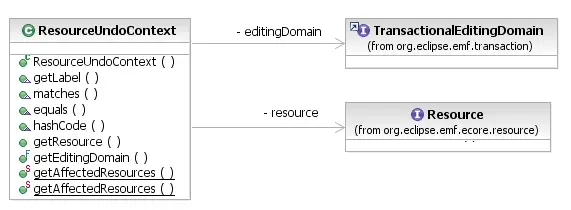One of the advantages of the Eclipse Operation History API is its ability to implement a
not-exactly-linear undo model, in which different operations executed on the same history
are only partially or not at all ordered, according to whether their contexts are
dependent. The IUndoContext API effectively implements multiple
undo "stacks" in a single history.
The workspace editing domain API provides a
ResourceUndoContext
that tags EMF operations with the Resources in the resource set
that they affect. Thus, in a single editing domain (on a single operation history), editors
on different resources can maintain separate undo stacks on the Edit
menu. Operations that affect multiple resources will appear in the Undo
menu action for multiple editors. Operations that affect only a single resource will not.

[
as SVG]
The IWorkspaceCommandStack listens to the execution of operations
on its IOperationHistory and automatically appends
ResourceUndoContexts for each resource affected by an operation.
It determines affected resources by analysis of Notifications,
using the following rules:
- the resource containing the notifier of a notification is, obviously, affected
- in the case of a change to an EReference, the resources
containing any objects added to or removed from the reference value are affected.
This holds for bidirectional references (having eOpposites)
and for unidirectional references, in the latter case because the API assumes that
there may be some implicit or derived dependency in the opposite direction
Clients can use the ResourceUndoContext.getAffectedResources(List)
API to compute the resources affected by a transaction themselves, if they are not using
a workspace command stack on their operation history.
An editor that uses a resource context as its editor context will populate its undo and
redo menus with operations that affected its resource. The
workspace-integrated editor example
demonstrates exactly this.
Copyright (c) 2006, 2007 IBM Corporation and others. All Rights Reserved.
